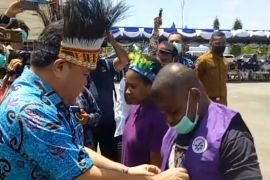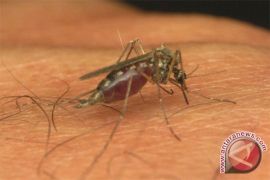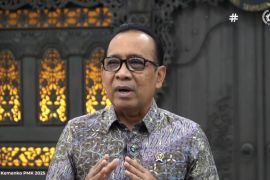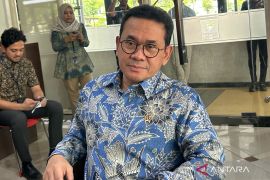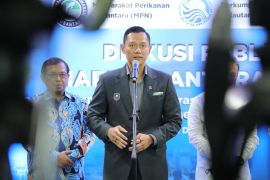According to the Indonesian Health Ministry`s Director General of Disease Control and Environmental Health (P2PL) Prof dr Tjandra Yoga Aditama, a 2010 World Malaria Report said half of the earth population is at risk of malaria where 81 million malaria positive cases were reported with a mortality rate of up to 117,704 people.
In Indonesia, there are approximately 544,470 malaria cases with a mortality rate of the infectious malignant disease of up to 900 people, Tjandra said.
Malaria is an infectious disease caused by Plasmodium parasite that lives and spawn in the the human blood, the various Plasmodium parasites in malaria namely Plasmodium Falciparum, Plasmodium Vivax, Plasmodium Ovale, Plasmodium Malariae and the recently discovered Plasmodium Knowlesi.
The most common Plasmodium in Indonesia is Falciparum and Vivax, meanwhile Plasmodium Malriae can be found in several Indonesian provinces such as Lampung, East Nusa Tenggara and Papua, where Plasmodium Ovale in East Nusa Tenggara and Papua.
In the meantime, Plasmodium Knowlesi is discovered in Kalimantan and is still being studied in research to find the main cause of Malaria.
Half of the malaria cases in Indonesia are caused by Plasmodium Falciparum and Vivax.
Plasmodium attacked Anopheles mosquitoes and spreads through three components known as the malaria epidemiology triangle.
Malaria Epidemiology Triangle consists of the host (people) spread by human risky behavior like outdoor activities during night time where the mosquitoes usually bite, secondly is the agent or the mosquitoes itself of the malaria vector types and genetically its application depends on the types and climate.
The environment is the other factor in the triangle, the disease might break out in climate changes and ecology vector such as density, population competency and genetic vector.
According to Tjandra, malaria clinical symptoms are mostly known as Trias Malaria causing fever, shivering and sweat, followed by other symptoms such as head ache, nausea, vomitting, diarrhea, and muscle aches.
Malaria`s worst symptoms can also felt by infected persons suffering from consciousness, weakness, spasm, high fever, yellowish eyes and body, bleeding nose, gums and indigestion, fast breathing or hard to breathe, less and darker urine and pale palm.
Medical Treatment for malaria
"Malaria can be treated after the patient`s blood has been monitored using a microscopic and Rapid Diagnose Test (RDT) , treatment using the Artemisinin Based Combination Therapy (ACT) and the government provided drugs at state hospitals and community health services (Puskesmas)," said Tjandra.
Malaria can be cured by using the right medication, otherwise it might cause death in less than seven days after being infected or illness may re-occur if the patient does not take the proper drugs in a certain period.
Tjandra also asked patients to have their malignant disease treated as soon aspossible in 24 hours to prevent complications from affecting other body parts.
According to global commitments in the Millennium Development Goals (MDGs) and Roll Back Malaria (RBM) and national commitment in Mid-Term Development Plans (RPJM), Presidential Decree no 3 to achieve the MDGs, and Regional Action Plan (RAD), the government plans to eliminate malaria in Indonesia.
The government plans to eliminate malaria with its vision to create independent people living healthily, and to create a healthy and malaria free community.
Government`s Efforts to Fight Malaria
Malaria in Indonesia is being eliminated several phases; in Jakarta in 2010 and in Bali and Batam are under the elimination process.
Tjandra said that in 2015 in Java, Nanggroe Aceh Darussalam (NAD) and Riau Islands, whereas in Sumatra, West Nusa Tenggara, Kalimantan, and Sulawesi in 2020, in Papua, West Papua, Maluku, West Maluku, and East Nusa Tenggara in 2030.
The Government`s program is aimed at high malaria risk citizens in endemic areas, with several key policies such as using RDT for malaria case confirmation, ACT drug treatment, prevention act using the long lasting insecticide Net (LLIN) distribution, Indoor Residual Spraying (IRS), repellent and larva siding.
Besides, the program also aims to enhance community based malarial monitoring posts, and with the "Gebrak Malaria" partnership.
In supporting malaria elimination targets according to MDGs, the government launched programs of the early discovery and treatment of infected people, improving quality health services, community empowerment, enhanced communication, information and education, partnership, increase surveillance monitoring and evaluation and improve human resources.
Malaria cases are reported with Annual Parasite Incidents (API: confirmed cases year per in the population under surveillance times 1000) where in 1990 the API number was 4.6 per 1000 and decreased in 2010 to 1.96 API per 1000 people.
"2009 and 2010 malaria elimination achievements have shown a good record whereas the API number is decreasing in the provinces despite the wide API number disparity," Tjandra said.
World Malaria Day
The world commemorates World Malaria Day on April 25, 2011 as a global momentum to improve the fight against a disease that attacks an estimated 500 million people worldwide every year.
The disease is spread by anopheles mosquitoes also claimed at least one million lives worldwide each year, mostly in sub-Saharan region.
In Indonesia the 2011 World Malaria Day Celebration have two themes that goes inline with one another, the global theme of Achieving Progress and Impact and the national theme is Malaria-Free, Investment Nation
According to the World Health Assembly (WHA) consensus in 2007, April 25 is celebrate as World Malaria Day and since 2008 the event is celebrated by every country in the world.(*)
Malaria in Indonesia is being eliminated several phases; in Jakarta in 2010 and in Bali and Batam are under the elimination process.
Tjandra said that in 2015 in Java, Nanggroe Aceh Darussalam (NAD) and Riau Islands, whereas in Sumatra, West Nusa Tenggara, Kalimantan, and Sulawesi in 2020, in Papua, West Papua, Maluku, West Maluku, and East Nusa Tenggara in 2030.
The Government`s program is aimed at high malaria risk citizens in endemic areas, with several key policies such as using RDT for malaria case confirmation, ACT drug treatment, prevention act using the long lasting insecticide Net (LLIN) distribution, Indoor Residual Spraying (IRS), repellent and larva siding.
Besides, the program also aims to enhance community based malarial monitoring posts, and with the "Gebrak Malaria" partnership.
In supporting malaria elimination targets according to MDGs, the government launched programs of the early discovery and treatment of infected people, improving quality health services, community empowerment, enhanced communication, information and education, partnership, increase surveillance monitoring and evaluation and improve human resources.
Malaria cases are reported with Annual Parasite Incidents (API: confirmed cases year per in the population under surveillance times 1000) where in 1990 the API number was 4.6 per 1000 and decreased in 2010 to 1.96 API per 1000 people.
"2009 and 2010 malaria elimination achievements have shown a good record whereas the API number is decreasing in the provinces despite the wide API number disparity," Tjandra said.
World Malaria Day
The world commemorates World Malaria Day on April 25, 2011 as a global momentum to improve the fight against a disease that attacks an estimated 500 million people worldwide every year.
The disease is spread by anopheles mosquitoes also claimed at least one million lives worldwide each year, mostly in sub-Saharan region.
In Indonesia the 2011 World Malaria Day Celebration have two themes that goes inline with one another, the global theme of Achieving Progress and Impact and the national theme is Malaria-Free, Investment Nation
According to the World Health Assembly (WHA) consensus in 2007, April 25 is celebrate as World Malaria Day and since 2008 the event is celebrated by every country in the world.(*)
A050/H-NG/F001
Reporter: Ageng Wibowo
Editor: Jafar M Sidik
Copyright © ANTARA 2011

